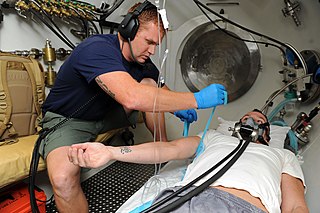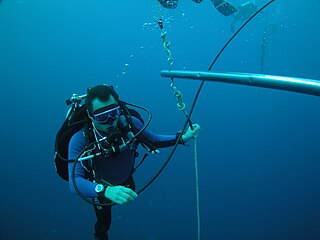
Decompression sickness is a medical condition caused by dissolved gases emerging from solution as bubbles inside the body tissues during decompression. DCS most commonly occurs during or soon after a decompression ascent from underwater diving, but can also result from other causes of depressurisation, such as emerging from a caisson, decompression from saturation, flying in an unpressurised aircraft at high altitude, and extravehicular activity from spacecraft. DCS and arterial gas embolism are collectively referred to as decompression illness.

A dive computer, personal decompression computer or decompression meter is a device used by an underwater diver to measure the elapsed time and depth during a dive and use this data to calculate and display an ascent profile which, according to the programmed decompression algorithm, will give a low risk of decompression sickness.
The Bühlmann decompression algorithm is a mathematical model (algorithm) of the way in which inert gases enter and leave the human body as the ambient pressure changes. Versions are used to create Bühlmann decompression tables and in personal dive computers to compute no-decompression limits and decompression schedules for dives in real-time. These decompression tables allow divers to plan the depth and duration for dives and the required decompression stops.

Submarine Escape Immersion Equipment (SEIE), also known as Submarine Escape and Immersion Equipment, is a whole-body suit and one-man life raft that was first produced in 1952. It was designed by British company RFD Beaufort Limited and allows submariners to escape from a sunken submarine. The suit also provides protection against hypothermia and has replaced the Steinke hood rescue device. The suit allows survivors to escape a disabled submarine at depths down to 600 feet (183 m), with an ascent speed of 2–3 meters/second, at a rate of eight or more sailors per hour.

Capt. Edward Deforest Thalmann, USN (ret.) was an American hyperbaric medicine specialist who was principally responsible for developing the current United States Navy dive tables for mixed-gas diving, which are based on his eponymous Thalmann Algorithm (VVAL18). At the time of his death, Thalmann was serving as assistant medical director of the Divers Alert Network (DAN) and an assistant clinical professor in anesthesiology at Duke University's Center for Hyperbaric Medicine and Environmental Physiology.
In physiology, isobaric counterdiffusion (ICD) is the diffusion of different gases into and out of tissues while under a constant ambient pressure, after a change of gas composition, and the physiological effects of this phenomenon. The term inert gas counterdiffusion is sometimes used as a synonym, but can also be applied to situations where the ambient pressure changes. It has relevance in mixed gas diving and anesthesiology.

The United States Navy Experimental Diving Unit is the primary source of diving and hyperbaric operational guidance for the US Navy. It is located within the Naval Support Activity Panama City in Panama City Beach, Bay County, Florida.
Professor Albert Alois Bühlmann was a Swiss physician who was principally responsible for a number of important contributions to decompression science at the Laboratory of Hyperbaric Physiology at the University Hospital in Zürich, Switzerland. His impact on diving ranged from complex commercial and military diving to the occasional recreational diver. He is held in high regard for his professional ethics and attention to his research subjects.

The decompression of a diver is the reduction in ambient pressure experienced during ascent from depth. It is also the process of elimination of dissolved inert gases from the diver's body which accumulate during ascent, largely during pauses in the ascent known as decompression stops, and after surfacing, until the gas concentrations reach equilibrium. Divers breathing gas at ambient pressure need to ascend at a rate determined by their exposure to pressure and the breathing gas in use. A diver who only breathes gas at atmospheric pressure when free-diving or snorkelling will not usually need to decompress, Divers using an atmospheric diving suit do not need to decompress as they are never exposed to high ambient pressure.

The practice of decompression by divers comprises the planning and monitoring of the profile indicated by the algorithms or tables of the chosen decompression model, to allow asymptomatic and harmless release of excess inert gases dissolved in the tissues as a result of breathing at ambient pressures greater than surface atmospheric pressure, the equipment available and appropriate to the circumstances of the dive, and the procedures authorized for the equipment and profile to be used. There is a large range of options in all of these aspects.

Decompression in the context of diving derives from the reduction in ambient pressure experienced by the diver during the ascent at the end of a dive or hyperbaric exposure and refers to both the reduction in pressure and the process of allowing dissolved inert gases to be eliminated from the tissues during this reduction in pressure.

Decompression theory is the study and modelling of the transfer of the inert gas component of breathing gases from the gas in the lungs to the tissues and back during exposure to variations in ambient pressure. In the case of underwater diving and compressed air work, this mostly involves ambient pressures greater than the local surface pressure, but astronauts, high altitude mountaineers, and travellers in aircraft which are not pressurised to sea level pressure, are generally exposed to ambient pressures less than standard sea level atmospheric pressure. In all cases, the symptoms caused by decompression occur during or within a relatively short period of hours, or occasionally days, after a significant pressure reduction.

There are several categories of decompression equipment used to help divers decompress, which is the process required to allow divers to return to the surface safely after spending time underwater at higher ambient pressures.
Brian Andrew Hills, born 19 March 1934 in Cardiff, Wales, died 13 January 2006 in Brisbane, Queensland, was a physiologist who worked on decompression theory.

The thermodynamic model was one of the first decompression models in which decompression is controlled by the volume of gas bubbles coming out of solution. In this model, pain only DCS is modelled by a single tissue which is diffusion-limited for gas uptake and bubble-formation during decompression causes "phase equilibration" of partial pressures between dissolved and free gases. The driving mechanism for gas elimination in this tissue is inherent unsaturation, also called partial pressure vacancy or the oxygen window, where oxygen metabolised is replaced by more soluble carbon dioxide. This model was used to explain the effectiveness of the Torres Straits Island pearl divers empirically developed decompression schedules, which used deeper decompression stops and less overall decompression time than the current naval decompression schedules. This trend to deeper decompression stops has become a feature of more recent decompression models.

The physiology of decompression is the aspect of physiology which is affected by exposure to large changes in ambient pressure, and involves a complex interaction of gas solubility, partial pressures and concentration gradients, diffusion, bulk transport and bubble mechanics in living tissues. Gas is breathed at ambient pressure, and some of this gas dissolves into the blood and other fluids. Inert gas continues to be taken up until the gas dissolved in the tissues is in a state of equilibrium with the gas in the lungs,, or the ambient pressure is reduced until the inert gases dissolved in the tissues are at a higher concentration than the equilibrium state, and start diffusing out again.
Henry Valence "Val" Hempleman was a researcher in the field of diving decompression.
The US Navy has used several decompression models from which their published decompression tables and authorized diving computer algorithms have been derived. The original C&R tables used a classic multiple independent parallel compartment model based on the work of J.S.Haldane in England in the early 20th century, using a critical ratio exponential ingassing and outgassing model. Later they were modified by O.D. Yarborough and published in 1937. A version developed by Des Granges was published in 1956. Further developments by M.W. Goodman and Robert D. Workman using a critical supersaturation approach to incorporate M-values, and expressed as an algorithm suitable for programming were published in 1965, and later again a significantly different model, the VVAL 18 exponential/linear model was developed by Edward D. Thalmann, using an exponential ingassing model and a combined exponential and linear outgassing model, which was further developed by Gerth and Doolette and published in Revision 6 of the US Navy Diving Manual as the 2008 tables.











